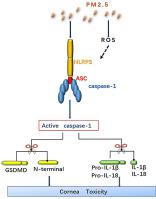Ecotoxicology and Environmental Safety ( IF 6.2 ) Pub Date : 2020-09-16 , DOI: 10.1016/j.ecoenv.2020.111306 Liangliang Niu 1 , Liping Li 1 , Chao Xing 2 , Bin Luo 3 , Chunchun Hu 1 , Maomao Song 1 , Jingping Niu 4 , Ye Ruan 4 , Xinghuai Sun 5 , Yuan Lei 6

|
Although studies have demonstrated that fine particulate matter (PM2.5) induces ocular surface damage, PM2.5 exposure causes cornea toxicity is not entirely clear. The aim of this study is to investigate the role of the nod-like receptor family pyrin domain containing three (NLRP3) inflammasome-mediated pyroptosis in PM2.5-related corneal toxicity. Human corneal epithelial cells (HCECs) were exposed to different concentrations of PM2.5, and the cell viability, expressions of NLRP3 inflammasome mediated pyroptosis axis molecules and intracellular reactive oxygen species (ROS) formation were measured in HCECs. Animal experiments were undertaken to topically apply PM2.5 suspension to mouse eyes for three months and the pyroptosis related molecules in the mouse corneas were measured.
Results
Our results showed a dose-dependent decrease of HCEC viability in the PM2.5-treated cells. NLRP3 inflammasome-mediated pyroptosis axis (NLRP3, ASC, GSDMD, caspase-1, IL-1β, and IL-18) were activated in the PM2.5-treated HCECs, accompanied by increased ROS formation. Further in vivo study confirmed the activation of this pathway in the mouse corneas exposed to PM2.5. In conclusion, this study provids novel evidence that PM2.5 induces corneal toxicity by triggering cell pyroptosis.
中文翻译:

空气中的颗粒物(PM2.5)通过NLRP3激活触发角膜发炎和细胞凋亡。
尽管研究表明细颗粒物(PM 2.5)会引起眼表损伤,但PM2.5暴露引起的角膜毒性尚不完全清楚。这项研究的目的是调查包含三个(NLRP3)炎性小体介导的凋亡的nod样受体家族吡啶结构域在PM 2.5相关角膜毒性中的作用。将人角膜上皮细胞(HCEC)暴露于不同浓度的PM 2.5,并在HCEC中测量细胞活力,NLRP3炎性小体介导的热解轴分子的表达和细胞内活性氧(ROS)的形成。进行了动物实验以局部施用PM 2.5 将其悬浮于小鼠眼中三个月,并测量小鼠角膜中与凋亡相关的分子。
结果
我们的结果表明,在PM 2.5处理的细胞中,HCEC活力呈剂量依赖性降低。在PM 2.5处理的HCEC中激活了NLRP3炎性体介导的焦磷酸化轴(NLRP3,ASC,GSMDD,caspase-1,IL-1β和IL-18),并伴随着ROS形成增加。进一步的体内研究证实了暴露于PM 2.5的小鼠角膜中该途径的激活。总而言之,这项研究提供了新的证据,表明PM 2.5通过触发细胞凋亡来诱导角膜毒性。











































 京公网安备 11010802027423号
京公网安备 11010802027423号